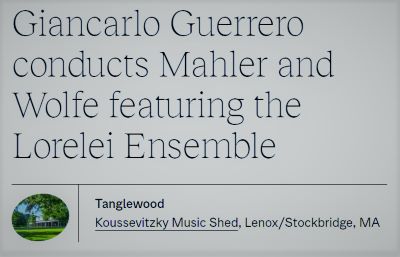REMEMBER THE LADIES
The double bill of Julia Wolfe’s Her Story and Gustav Mahler’s Symphony No. 1 in D Major brought two distinct types of pleasure to an appreciative audience at Tanglewood on Friday, July 28. The Boston Symphony Orchestra performed both works; Her Story featured the all-female choral group Lorelei Ensemble. Personable and puissant conductor Giancarlo Guerrero did not disappoint in his delivery of these two works separated by more than a century.
Giancarlo Guerrero conducts Her Story with the Lorelai Ensemble at Tanglewood
Her Story, commissioned by the Boston Symphony Orchestra, the Chicago Symphony Orchestra, the Nashville Symphony, the National Symphony Orchestra, and the San Francisco Symphony Orchestra, was intended to mark the 2020 centennial of the 19th Amendment which established the right of women to vote. Due to the pandemic, the piece did not premiere until September 2022, when Guerrero conducted it with Lorelei Ensemble and the Nashville Symphony Orchestra. The approximately 40-minute-long choral work is scored for a large orchestra and includes electric guitars as well as strings, wind and brass instruments, a harp, and multiple percussionists.
The Lorelai Ensemble and the BSO perform Julia Wolfe's Her Story
The performance combined displayed text, costuming, and gesture with composer Wolfe’s signature use of repetition and minimalism for a thrilling and stimulating experience. The chorus took the stage in long gray dresses, their right hands clad in red gloves. The first section of the piece, “Foment,” used driving repetition to deliver Abigail Adams’s request that her husband John Adams and the other framers of the Constitution “remember the ladies” and urges that the founding document include protections for women’s rights. The falling violin glissando on the word husbands (in the phrase Do not put such unlimited power in the hands of husbands) seems to prefigure the destruction of patriarchal marriage, but the Constitution ratified in 1789 included no acknowledgement of women’s rights.
the BSO and Lorelai Ensemble perform Julia Wolfe's Her Story at Tanglewood
The longer second section, “Raise,” presented insults employed by those who opposed women’s suffrage, many on large placards. The last part of that section draws on the “Ain’t I a Woman” speech traditionally attributed to Sojourner Truth, at which point members of the chorus moved to the front of the stage and assisted one another in removing the gray bodices of their costumes to reveal black-and-white tank tops and brilliant green and purple linings beneath their gray skirts. The powerful performance, the beautiful and yet challenging score, and the striking costuming were intoxicating and intriguing. I did wonder why was the text from Abigail Adams’s letter was displayed but not that of the speech attributed to Truth. And why were the insults used during the suffrage campaign presented before the excerpts from Truth, when her speech was delivered early in the campaign? And why did the composition describe the efforts to secure women’s suffrage, but not the success of the effort? These questions aside, the performance of this ground-breaking work was a memorable and inspiring experience.
The Lorelai Ensemble performs Julia Wolfe's Her Story with the BSO at Tanglewood
Following intermission was Gustav Mahler’s Symphony No. 1, a composition with a long history of revision. First performed as a five-movement “symphonic poem” in 1889, Mahler continued to work on it until he presented it as a four-movement symphony in 1896. It is a good choice to pair with the Wolfe, because like Her Story, it requires a large orchestra to achieve the variety of sounds and effects Mahler desired. According to Mahler’s shrink, a fellow by the name of Sigmund Freud, “the conjunction of high tragedy and light amusement” were permanently linked for Mahler, following a childhood incident in which he ran out into the street to avoid the sound of his parents quarreling and heard an organ-grinder playing a cheery tune.
Giancarlo Guerrero conducts the BSO at Tanglewood
Under Guerrero’s energetic and stylish conducting, the BSO emphasized the contrasts and subtleties of this complex work, playing up the ironic and at times humorous aspects, including the waltz-tempo Ländler, or folk songs, the children’s song known as “Frere Jacques” in a minor key, the klezmer-flavored passages, and the ironic funeral march (inspired by a woodcut titled The Hunter’s Funeral,” in which game animals pretend to be grief-stricken). Guerrero brought these light-hearted elements to prominence, highlighting the contradictions and ambivalence in this work, one in which Mahler struggles with the beauty of some of the more lyrical passages by introducing sudden shifts of key or tempo that force us to question the extent to which we can trust the beauty we have heard. As with Wolfe, Mahler was at the forefront of musical innovation in his time, combining elements of romanticism and modernism in his use of unconventional scoring and organization.
Giancarlo Guerrero conducts the BSO at Tanglewood
photos by Hilary Scott
Giancarlo Guerrero Conducts Mahler & Wolfe
Boston Symphony Orchestra
Tanglewood, Koussevitzky Music Shed, 297 West St in Lenox, MA
played July 28, 2023
for future events, call 617-266-1200 or visit BSO

